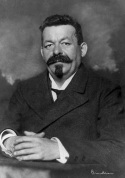Friedrich Ebert
1871-1925
- Chairman of the SPD (Social Democrats)
- Chairman of the Council of People’s Representatives
- Reichspräsident from 1919 to 1925
Friedrich Ebert was part of the Social Democrats’ leadership. He became the party’s chairman in 1913. During the November Revolution he became chairman of the Council of People’s Representatives and in 1919 the Weimar Republic’s first Reichspräsident. He led the democracy through its difficult first years, having to endure vicious attacks from both the left and the right. His early death in 1925 robbed the republic of its greatest emblematic leader.




